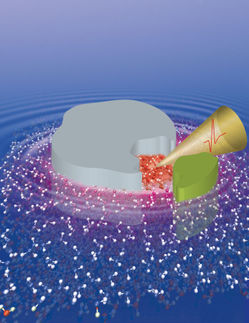Combating infection of crops by nematodes is soon to improve
Scientists from Ghent University and VIB have succeeded in showing how nematodes are able to manipulate the transport of the plant hormone auxin in order to force the plant to produce food for them. This advancement in knowledge about this process opens new possibilities for the development of nematode-resistant plants.
Nematodes are small worms. Some species are plant-parasitic and infect plants including important agricultural crops. The typical symptoms of a nematode-infection are withering, seriously retarded growth, and impaired development of flower and fruit. Severely infected plants often do not survive the damage that the worms inflict. Each year, plant-parasitic nematodes cause more than 80 billion euro in agricultural losses worldwide. Plant roots as food factories Some of these nematodes have developed an ingenious way of making a plant feed them. They penetrate the plant’s roots and make their way to their host’s vascular bundles, which are part of the plant’s transport system for water, minerals, sugars, and other nutrients. The nematodes select a single plant cell in the vascular bundle system and then inject this cell with a cocktail of proteins. The activating influence of these proteins causes the plant cell to merge with neighboring cells and to start producing food for the nematode. This plant cell − which can become as large as 200 normal plant cells − is called the nematode feeding site.
Research has revealed that nematodes mislead the plant by disrupting its hormonal regulation. The plant hormone auxin, which is important for nearly every one of the plant’s developmental processes, accumulates at the site of infection. Later, when the feeding site needs to grow, auxin accumulates in the neighboring plant cells. Until now, scientists have not known how nematodes manipulate the transport of auxin.
Wim Grunewald and his colleagues from VIB and Ghent University have been studying the role of PIN proteins in a popular model plant: the mouse ear cress (Arabidopsis thaliana). These plant proteins enable the transport of auxin from one cell to another. To discover the specific function of the various PIN proteins, the researchers have used plants that, through manipulation, are not able to produce PIN1, PIN2, PIN3, PIN4 or PIN7. In this way, the researchers have been able to show that nematodes knock out certain of the plant’s PIN proteins, while other PIN proteins are activated just to transport auxin to the neighboring cells. With this discovery, the scientists are taking us a step closer towards fully understanding the way in which nematodes feed themselves through plants. Ways to thwart the nematodes can then be invented − for example, by locally counteracting the nematodes’ manipulation of auxin transport. Because current methods for protecting agricultural and other crops against nematodes require substances that are very environmentally unfriendly, this finding can lead to important improvements in combating this costly problem.
Original publication: Grunewald et al., "Plant-parasitic nematodes manipulate PIN-mediated auxin transport to facilitate infection"; PloS Pathogens.
Other news from the department science

Get the life science industry in your inbox
By submitting this form you agree that LUMITOS AG will send you the newsletter(s) selected above by email. Your data will not be passed on to third parties. Your data will be stored and processed in accordance with our data protection regulations. LUMITOS may contact you by email for the purpose of advertising or market and opinion surveys. You can revoke your consent at any time without giving reasons to LUMITOS AG, Ernst-Augustin-Str. 2, 12489 Berlin, Germany or by e-mail at revoke@lumitos.com with effect for the future. In addition, each email contains a link to unsubscribe from the corresponding newsletter.

















































